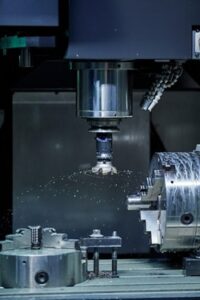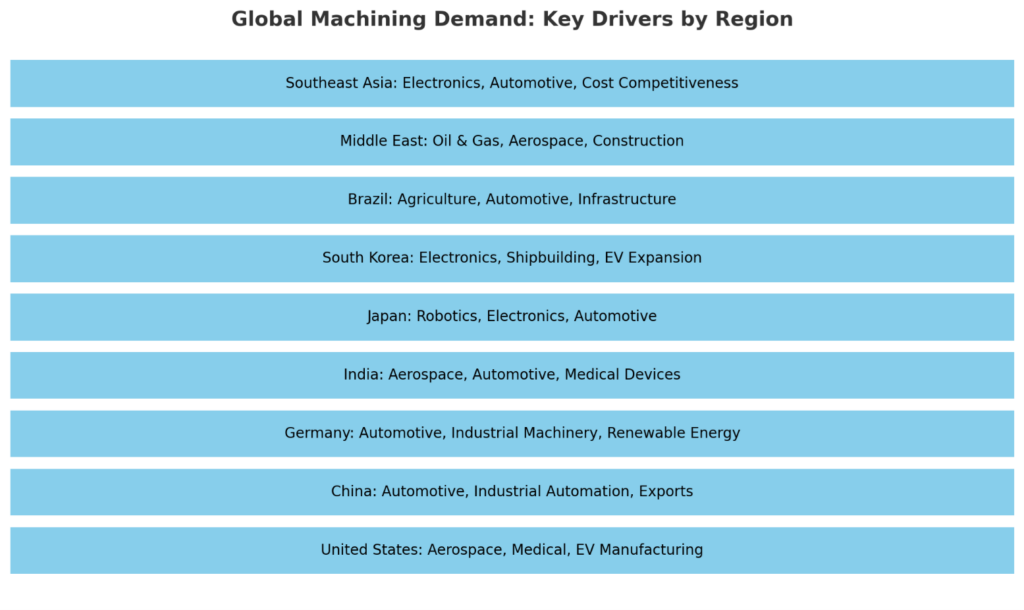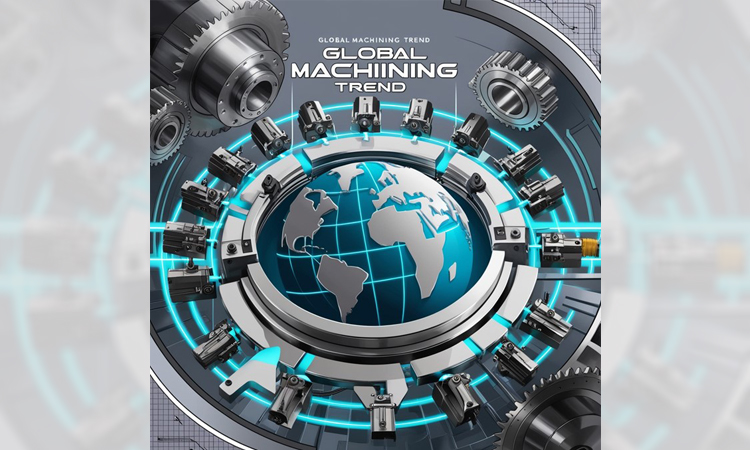The machining industry is at a pivotal moment, driven by rapid advancements in technology, shifting economic landscapes, and evolving global demands. From precision manufacturing to sustainable machining practices, the future of this industry promises a transformative era. This article delves into the anticipated future trends and provides a country-wise breakdown of regions poised for higher demand.
Global Trends Shaping the Machining Industry

- Integration of Automation and Artificial Intelligence (AI): Automation and AI are revolutionizing machining operations. From predictive maintenance powered by machine learning to AI-enabled design optimizations, the integration of smart technologies is increasing efficiency, reducing errors, and lowering operational costs. Robotic machining systems and AI-driven quality assurance tools will dominate the sector in the coming years.
- Adoption of Additive Manufacturing (AM): Additive manufacturing, especially 3D printing, is complementing traditional machining processes. This hybrid approach enhances customization capabilities, reduces material waste, and shortens product development cycles. Medical devices, aerospace components, and automotive prototypes are leading applications driving the demand for AM-enhanced machining.
- Sustainability and Green Machining Practices: With industries worldwide emphasizing carbon neutrality, green machining practices are becoming the norm. The use of biodegradable coolants, energy-efficient machinery, and the recycling of cutting fluids is expected to grow significantly.
- Shift to Micro-Machining: The demand for compact, precise components is driving the need for micro-machining. Applications in electronics, medical implants, and aerospace systems are fueling this trend, requiring the development of ultra-precise machining tools and techniques.
- Digital Transformation and Industry 4.0: The fourth industrial revolution is embedding IoT, cloud computing, and real-time analytics into machining processes. Smart factories equipped with interconnected systems are streamlining operations, improving production quality, and enabling remote monitoring.
- Rising Demand for Customization: As industries cater to diverse and dynamic consumer needs, the demand for customized machining solutions is rising. This trend is pushing manufacturers to adopt flexible, modular machining systems.

Let us delve into country wise scenario & key effecting factors:
United States
The United States remains a major hub for machining, driven by robust demand from the aerospace, defense, automotive, and medical sectors. The following trends are shaping its market:
-
- Aerospace Dominance: With Boeing, Lockheed Martin, and other aerospace giants headquartered in the U.S., the demand for precision machining of high-performance materials is strong.
- Medical Machining: The aging population is fueling demand for medical devices and implants, requiring advanced micro-machining and additive manufacturing.
- EV Manufacturing: The push for electric vehicles (EVs) is driving demand for machined components such as battery enclosures, motor casings, and lightweight parts.
China
China leads the global manufacturing landscape and continues to dominate machining demand due to its expansive industrial base. Key drivers include:
-
- Automotive Production: As the largest producer of vehicles globally, China’s demand for machining is centered on drivetrain components, EV batteries, and lightweight materials.
- Industrial Automation: Rapid industrial automation is increasing demand for machined parts used in robotics and automated systems.
- Export-Driven Growth: The export of industrial machinery and equipment further bolsters China’s machining industry.
Germany
Germany’s machining industry is synonymous with precision and innovation. As Europe’s largest economy, it thrives on exports and advanced manufacturing technologies:
- Automotive Engineering: The presence of brands like BMW, Volkswagen, and Mercedes-Benz ensures consistent demand for high-precision machining.
- Industrial Machinery: Germany’s expertise in producing industrial machinery requires state-of-the-art machining processes.
- Renewable Energy: The push for renewable energy solutions is increasing demand for machined components used in wind turbines and solar panel infrastructure.
India
India is emerging as a key player in the machining industry, owing to its growing industrial base and cost advantages. Important sectors include:
- Aerospace and Defense: Initiatives like ‘Make in India’ are boosting demand for domestically machined aerospace and defense components.
- Automotive Sector: As one of the fastest-growing automotive markets, India’s machining industry is focusing on EV components and fuel-efficient designs.
- Medical Devices: The growth of healthcare infrastructure is driving demand for precise and biocompatible machined parts.
Japan
Japan continues to lead in high-precision machining technologies, with a focus on innovation and automation:
- Robotics and Automation: As a global leader in robotics, Japan’s demand for machined components in robotic systems is growing.
- Consumer Electronics: The miniaturization of electronics necessitates advanced micro-machining capabilities.
- Automotive Excellence: Japan’s automotive giants, such as Toyota and Honda, drive demand for high-performance machined components.
South Korea
South Korea’s machining industry is fueled by its prowess in electronics, shipbuilding, and automotive manufacturing:
- Electronics Manufacturing: Companies like Samsung and LG require precision machining for semiconductor and display components.
- Shipbuilding: As a leader in ship production, the demand for machined components in propulsion systems and hulls remains high.
- EV Expansion: South Korea’s investments in EVs are driving demand for lightweight and efficient machined parts.
Brazil
As a key player in South America, Brazil’s machining demand is shaped by its focus on agriculture, automotive, and infrastructure:
- Agricultural Machinery: The large agricultural sector requires machined components for tractors, harvesters, and irrigation systems.
- Automotive Growth: Brazil’s growing domestic car market fuels demand for machined parts.
- Infrastructure Projects: Machining plays a critical role in Brazil’s expanding infrastructure development.
Middle East
The Middle East’s machining industry is evolving, with a focus on oil and gas, aerospace, and construction:
- Oil and Gas Equipment: Precision machining is essential for exploration and drilling equipment.
- Aerospace Expansion: Nations like the UAE are investing heavily in aerospace, increasing the demand for high-quality machining.
- Construction Boom: Machined components are critical for advanced construction machinery and tools.
Southeast Asia
Countries like Vietnam, Thailand, and Indonesia are emerging as machining hubs, driven by their growing manufacturing base:
- Electronics Assembly: Southeast Asia is a major center for electronics production, requiring advanced machining capabilities.
- Automotive Production: The region’s expanding automotive industry is driving demand for machined components.
- Cost Competitiveness: Competitive labor costs and government incentives are attracting investments in machining.
The machining industry’s future is defined by technological innovation, sustainability, and regional diversification. Established leaders like the U.S., Germany, and Japan set benchmarks in advanced capabilities, while emerging economies such as India, China, and Southeast Asia are poised for remarkable growth.
To stay competitive, companies must adopt cutting-edge technologies like AI, IoT, and additive manufacturing, prioritize sustainability, and cultivate a skilled workforce. By embracing these strategies, the industry is prepared to navigate the evolving demands of a dynamic global market.
Image courtesy : Design by Freepik



